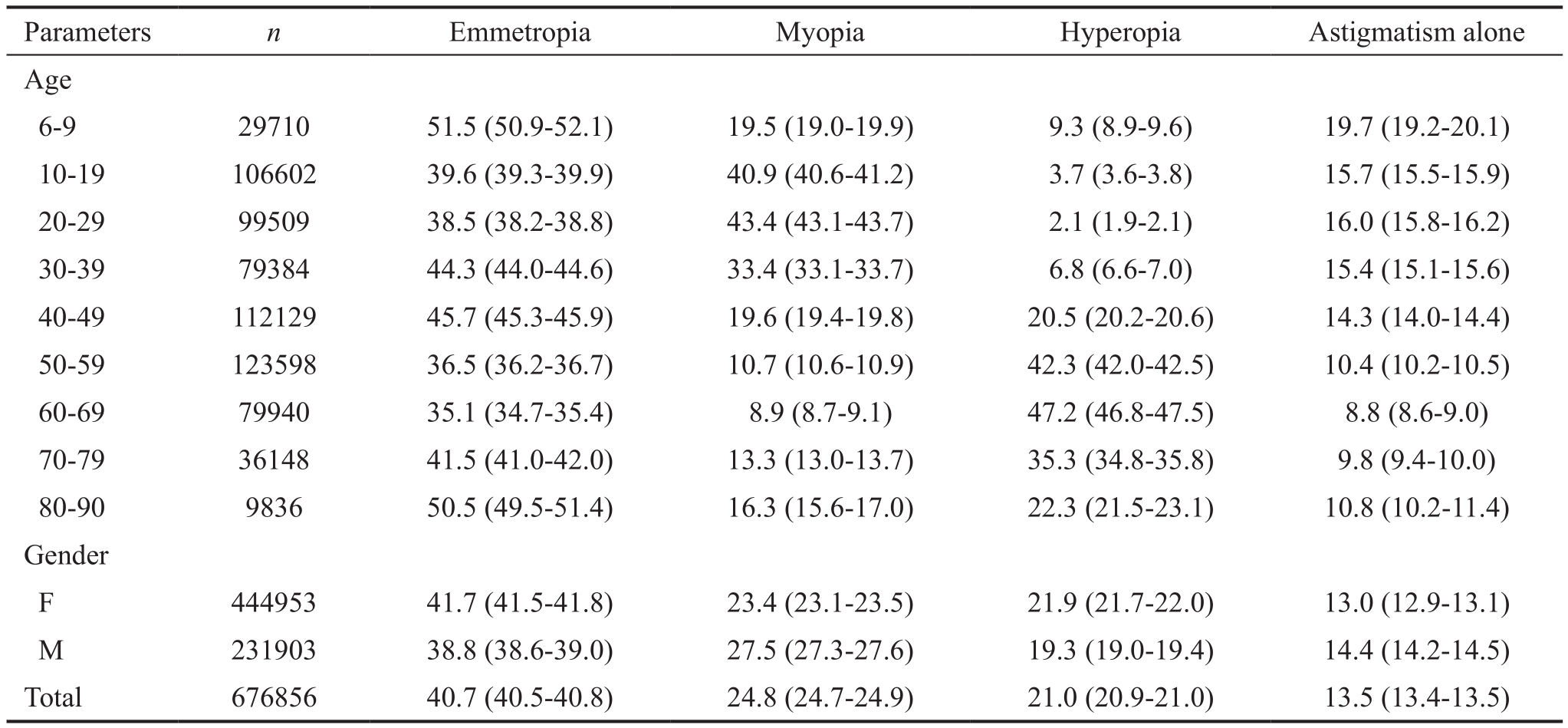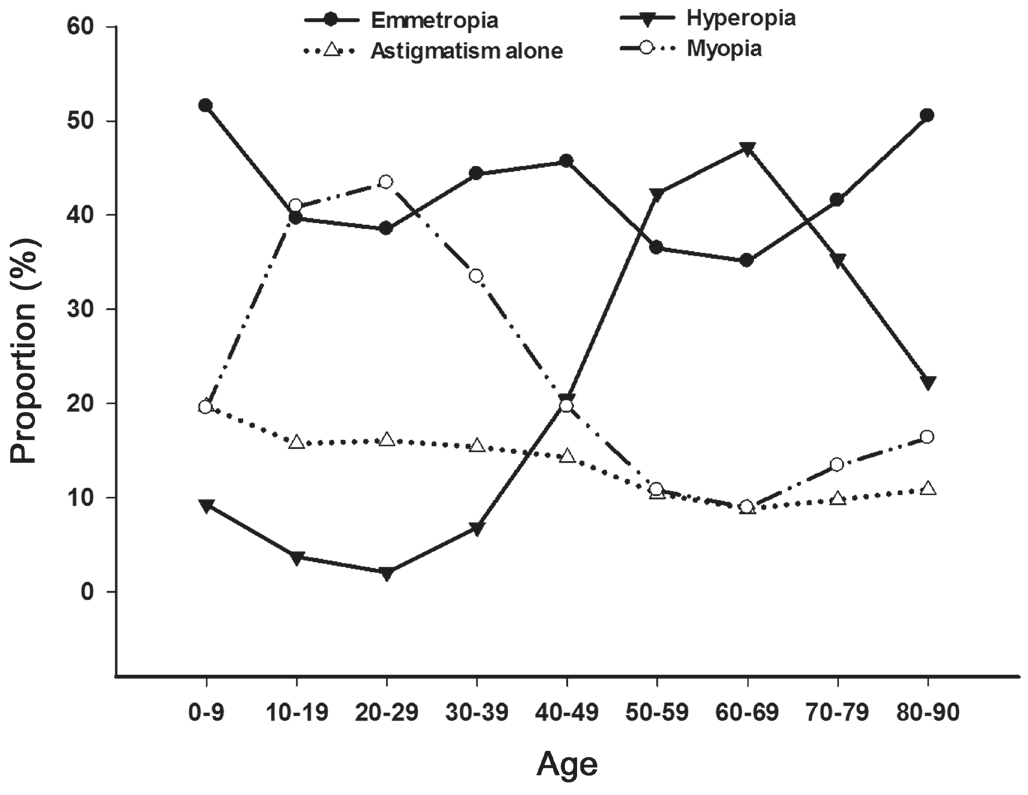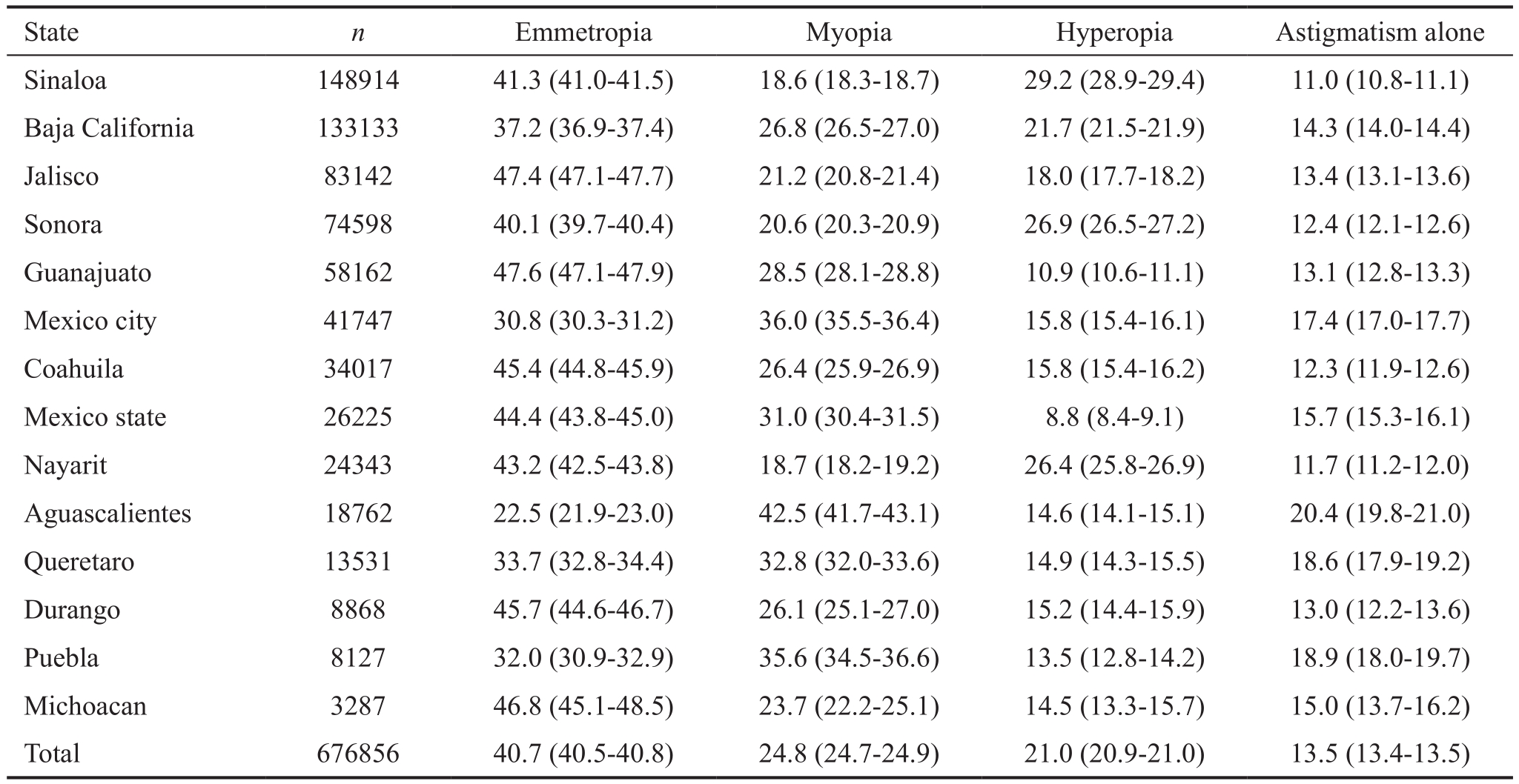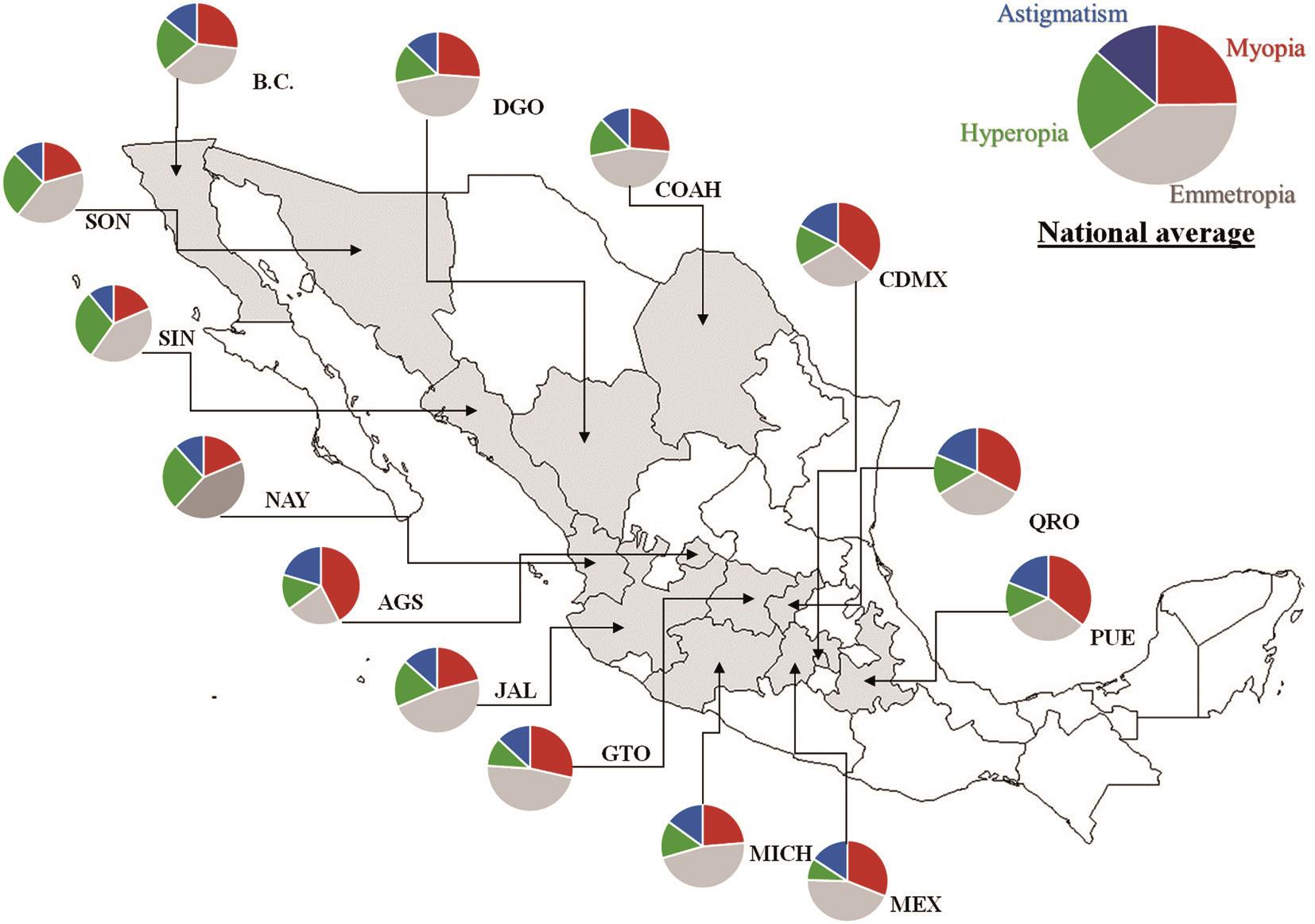INTRODUCTION
Refractive error is recognized as one of the most important causes of correctable visual impairment[1-4] and affects people of all ages, socio-economic statuses and ethnic groups. The World Health Organization (WHO) estimated that, globally, 285 million people were visually impaired,of whom 39 million were blind. According to the data from 2010, 80% of visual impairment, including blindness, is avoidable (it can be prevented or cured)[5]. Approximately 90%of visually impaired people live in developing countries[6].Vision impairment has been def i ned based on distance visual acuity only. Globally the major causes of visual impairment are: uncorrected refractive errors 43% (myopia, hyperopia or astigmatism alone), unoperated cataract 33% and glaucoma 2%[6].
Refractive error occurs when there is failure of the eye to correctly focus rays of light from an object onto the retinal plane. The resultant image perceived by the individual is blurred, and refractive correction is required to see clearly.Refractive error can be divided into myopia (short or nearsightedness), hyperopia (long or far-sightedness) and astigmatism (irregularly curved cornea)[7]. Refractive errors are not preventable but can easily be treated with corrective eye glasses, contact lenses or in some cases, corrective surgery.Visual impairment from uncorrected refractive errors can have immediate and long-term consequences in children and adults,such as lost educational and employment opportunities; lost economic gain for individuals, families and societies; and impaired quality of life[6].
The global magnitude of refractive error is not reliably known,as there is great variation in groupings according to age,definitions of blindness, and examination methods[5,8-10].However, specific data on refractive error prevalence in some countries are not available. For example, data on the prevalence of visual impairment in Mexico are lacking[11-15], as a national survey of blindness and visual impairment has not yet been conducted. For this reason, this study was conducted to determine the proportion of visual impairment attributable to refractive error in people from fourteen states of Mexico who attended at the optometry clinics of Salud Digna Para Todos,I.A.P. between 2014 and 2015. The outcome, following an assessment of the visual status of the population, could provide reliable information on the refractive error proportion in Mexico. To our knowledge, this is the fi rst report of refractive error in a Mexican population in several settings.
SUBJECTS AND METHODS
Design A cross-sectional study was conducted in patients who visited the Clinic of Salud Digna Para Todos, I.A.P (in fourteen states of Mexico), which offers laboratory services, X-ray and eye care services (visual examination services and spectacles).Patients who came for any laboratory service or visual examination were invited to participate in this study between 2014 and 2015. The selection of individuals was conducted using a non-probability sampling[16] with information on the refraction studies: a total of 676 856 subjects were selected and ranged in age from 6 to 90y of both genders. Each patient obtained and completed a consent and use of information authorization form during the registration process. Ethical approval was obtained from the Ethics Committee of the School of Medicine, Autonomous University of Sinaloa.
Refractive Error Criteria The refractive assessment was based on objective and subjective refraction with visual acuity assessment using a AKR700 autorefractor and APH 500 phoropter (Essilor Instruments, USA), respectively, according the manual of the National health and nutrition examination survey-CDC[17]. The target viewed by the subjects was initially an out of focus 20/40 line of letters, followed by a star pattern that is blurred during readings by the autorefractor.The last image viewed by the subject is a 20/40 line of letters that appears again at the end of the measurements[18]. The refractive errors were classified by the spherical equivalent(SE): sphere+½ cylinder. Myopia was classif i ed as a spherical equivalent >-0.50 D, hyperopia as a spherical equivalent>+0.50 D, and emmetropia as a spherical equivalent between-0.50 and +0.50. Astigmatism alone was equal to or higher than 0.25 D in minus cylinder form[19]. All of the refractive errors were obtained at the time of the visitusing a APH 500 phoropter (Essilor Instruments, USA) with a range from-20.00 D to +20.00 D and cylinder range -0.25 to -6.00 D.Because the refractiveerror between the right and left eye was similar (r=0.87; P>0.05), the right eye was selected for analysis. When necessary, patients with latent hyperopia were referred for consultation with or treatment by another health care provider or ophthalmologist. Patients with a documented history of cataract extraction (pseudophakiaora phakia),refractive surgery or other corneal/ocular surgery, amblyopia or any ocular disease were excluded from thestudy.
Statistical Analysis Descriptive statistics was used for data analysis. The proportion data are presented in tables, adopting 95% conf i dence intervals (CI) and P-values (signif i cant at the P<0.05 level). Proportion differences between age groups and gender were analyzed using the Chi-square test. The statistical analysis program SPSS V20 (SPSS Inc, Chicago, IL, USA)was used to perform the calculations.
RESULTS
Proportion of Refractive Errors by Age and Sex The sample distribution by age and sex is shown in Table 1. The distribution of refractive errors among the total population (from 6 to 90 years old) revealed that 24.8% (95% CI, 24.7-24.9) had myopia, 21.0% (95%CI, 20.9-21.0) had hyperopia and 13.5%(95% CI, 13.4-13.5) had astigmatism alone. The proportion of emmetropia among the total population was 40.7% (95% CI,40.5-40.8). Figure 1 shows the distribution of refractive errors(myopia, hyperopia and astigmatism alone) by age group.With increasing age, there was an increase in the proportion of hyperopia. Myopia decreases during aging with a small increase at 70. The proportion of astigmatism alone showed a signif i cant decreasing trend with age (6 to 90y; from 19.7% to 10.8%) (P<0.0001). The drop in the proportion of astigmatism alone was most pronounced in ages from 60-69y (8.8%). Theproportion of any clinically important refractive error (myopia,hyperopia, and astigmatism alone) was higher for those between the ages of 60-69 (64.9%) and 50-59 (63.5%) than between the ages of 6-9y (48.5%; P<0.0001) (Table 1).
Table 1 Proportion of refractive errors in the population of Mexico by age and sex % (95% CI)

Myopia (≤-0.75 D), hyperopia (≥+1 D) and astigmatism alone (≥-0.25 D).
The proportion of myopia was more common in males(27.5%) than females (23.4%) (P<0.0001, Table 1). Hyperopia was more frequent in females (21.9%) than males (19.3%;P<0.0001). Astigmatism alone was more frequent in males(14.4%) than females (13.0%) (P<0.0001). Emmetropia was more frequent in females (41.7%) than males (38.8%)(P<0.0001, Table 1). In general, the proportion of any clinically important refractive error was higher in males (61.2%) than in females (58.3%; P<0.0001).
Proportion of Refractive Error in Different Geographical Areas of the Country Myopia was most prevalent in Aguascalientes (42.5%), Mexico city (36.0%) and Puebla state(35.6%), compared with Sinaloa (18.6%), Nayarit (18.7%)and Sonora state (20.6%) (Table 2, Figure 2). The proportion of hyperopia was higher for Sinaloa (29.2%), Sonora (26.9%)and Nayarit state (26.4%) than for Mexico state (8.8%),Guanajuato (10.9%) and Puebla (13.5%). The proportion of astigmatism alone varied little by state. However, astigmatism alone was more prevalent in Aguascalientes (20.4%), Puebla(18.9%) and Queretaro state (18.6%) than in Sinaloa (11.0%),Nayarit (11.7%) and Coahuila state (12.3%). Emmetropia was most prevalent in Guanajuato (47.6%), Jalisco (47.4%) and Michoacan state (46.8%), compared with Aguascalientes (22.5%),Mexico city (30.8%) and Puebla states (32.0%).The proportion of any clinically important refractive error was highest for Aguascalientes (77.5%), Mexico city (69.2%) and Puebla states (68.0%), and it was lowest for Guanajuato (52.4%),Jalisco (52.6%) and Michoacan state (53.2%). The proportion of refractive error presented here (Table 2, Figure 2) shows variability among the proportions of emmetropia, myopia,hyperopia and astigmatism in different geographical areas of the country.

Figure 1 Proportion of refractive error by age groups Frequency of hyperopia increases with aging, with a small decrease at approximately 70 years of age. Myopia decreases during aging, with a small increase at 70 years of age.
DISCUSSION
Refractive errors are the most common cause of visual impairment worldwide, and their proportions are known to vary among societies with these differences being partly attributable to the genetic background and partly to environmental factors[20].Recently, numerous studies have examined the prevalence of different refractive errors in wide-ranging countries and societies, in relation to age, educational variables, or ethnic groups[6-7,10,21-25]. We determined the proportion of refractive conditions in the Mexican population that visited primary careoptometry clinics in fourteen states of Mexico. Refractive errors are common conditions affecting the ocular health of the Mexican population, involving children, young adults, middleaged persons, and older adults of all ethnicities and from different regions of Mexico. For our study, a total of 676 856 subjects were selected, and they ranged in age from 6 to 90y.We found that the proportion of refractive error presented here showed variability in different geographical areas of Mexico.Myopia was the most common refractive error, and the proportion seemed to increase among the younger population(10 to 29 years old), but hyperopia increased among the aging population (40 to 79 years old).
Table 2 Proportion of refractive error in different geographical areas of the country % (95% CI)


Figure 2 The proportion of refractive error in different states of Mexico from 2014-2015 Pie charts summarize the per-state average proportions of refractive errors. The national average of refractive errors was 24.8% for myopia (red color), 40.7% for emmetropia (gray color),21% for hyperopia (green color) and 13.5% for astigmatism alone (blue color). SON: Sonora; SIN: Sinaloa; NAY: Nayarit; AGS: Aguascalientes;JAL: Jalisco; GTO: Guanajuato; MICH: Michoacan; MEX: Mexico state; B.C.: Baja California; DGO: Durango; COAH: Coahuila; CDMX:Mexico city; QRO: Queretaro; PUE: Puebla. Astigmatism and myopia were more prevalent in AGS, and hyperopia was higher for SIN.
There are only a few publications regarding the proportion of refractive errors in Mexico. For example, the first study on the prevalence of refractive errors was presented by Ramos[14]as early as 1890, although he did not state his definition of myopia or other refractive errors. Baz Iglesias et al[11] reported the prevalence of refractive errors among a selected Mexican population visiting an optician in the 80’s, and Espinosa[26]analyzed a sample of college students for refractive errors.However, no author reported data necessary to compareto the current prevalence. Villarreal et al[15] in 2003 reported the prevalence of refractive errors, mainly myopia (44%),hyperopia (6%) and astigmatism (9.5%), among a total of 1035 schoolchildren from 12 to 13 years old in a metropolitan setting in Monterrey, Mexico. We detected similar data in this study from 10 to 19-year-old regarding myopia (40.9%),hyperopia (3.7%) and astigmatism (15.7%).
It is well known that both refractive errors and spherical and astigmatic errors change with age after maturity in males and females. A decrease in myopia and an increase in hyperopia with increasing age are commonly reported[19,23,27-29]. In this study, with increasing age, there is an increase in the proportion of hyperopia and myopia decreases during aging with a small increase at 70. The peak proportion of myopia was identif i ed in the 20-29 age-group. In older individuals, the proportion of myopia was lower in those 60-69 years old. This may ref l ect the rising proportion of myopia in younger generations, or the known hyperopic shift in aging[23,30]. Astigmatism rates were fairly constant (8.8%-19.7%) across cross-sectional age categories but were lower after the age of 60, across all age groups. We identified moderately more astigmatism in men (for example 13.0% in women and 14.4% in men). This fi nding contrasts with other studies, where persons 60y or older were less likely to have astigmatism than younger persons[31].Data from a Brazilian population showed that the main refractive error was astigmatism (59.7%), followed by hyperopia (33.8%) and myopia (25.3%)[27]. Similarly, Korean[32]and Puerto Rican[19] populations identif i ed astigmatism as the main refractive error in those populations (63.7% and 69.6%),followed by hyperopia (41.8% and 51.5%) and myopia (20.5%and 14.7%), respectively. In contrast, we report myopia as the main refractive error in our population (24.8%), followed by hyperopia (21.0%) and astigmatism (13.5%).
In the present report, we identified that the proportion of any clinically important refractive error was higher for those between the ages of 50-59 (63.5%) and 60-69 (64.9%) than between the ages of 6-9 (48.5%). This finding has been observed in other studies[33-34]. Approximately 65% of all people who are visually impaired are aged 50 and older while this age group comprises approximately 20% of the world's population.With an increasing elderly population in many countries, more people will be at risk of visual impairment due to chronic eye diseases and ageing processes. The number of children below age 15 that are visually impaired is estimated to be 19 million.Of these, 12 million children are visually impaired due to refractive errors, a condition that could be easily diagnosed and corrected[6]. The association of gender with refractive errors has not been well established. Some studies have reported that the prevalence of myopia is higher in men than in women[35-36].In other studies, however, this trend was not observed[31,37-38].In this study, clinically important refractive errors were more common in males than in females. The underlying cause of this gender variation should be explored further. In our sample of 676 856 subjects from fourteen States, we found that the refractive error proportion in Aguascalientes state was higher than the proportion in other states. The underlying cause of this geographic variation should be explored further (prevalence,distribution and demographic associations).
The World Health Organization’s Global Action Plan for 2014 to 2019 has identif i ed human resources for refractive error as a priority to reduce avoidable blindness globally[5,21]. Current challenges include the uneven distribution of refraction training institutions and a lack of standardization, which makes it difficult to maintain the quality of services. In Mexico,for example, competing eye health priorities also mean that providers of the health care system sometimes neglect refractive error services. In Mexico, it is necessary to provide refractive services at all levels of the health care system,especially at the primary level, where services are provided in the community.
The limitations of the current study included that the selection of individuals was conducted using non-probability sampling and the lack of a cycloplegic examination. Thus, despite possible limitations, a large national sample of patientswho came for any laboratory service or visual examination from fourteen states (676 856 people with 40.6% emmetropia) was used for the examination of refractive errors, which ensures some representation of our population. Furthermore, the overall prevalence of visual impairment due to uncorrected refractive error in adults and children has not been previously studied in Mexico. To our knowledge, this is the first report of refractive error in the Mexican population from several settings. The major strengths of our study are the large sample size, which contributed to the proportion estimates, and that all of the participants had the same eye examinations, providing a unique opportunity to estimate the burden of refractive error in younger, middle and older aged individuals across Mexico. There are inherent differences in the included studies in terms of the study design, refraction technique and cohort sampling, together with inter-region differences at the levels of urbanization, economy, education and climate, which may influence refractive error. Such information is crucial for resource allocation, planning, and the development of health and educational policy interventions to ameliorate the burden of visual impairment in the population.
ACKNOWLEDGEMENTS
The Map of Eye health project is sponsored by the Salud Digna Para Todos, I.A.P. and PROMEP/2014 DSA/103.5/14/11063--,Folio UAS-PTC-121-(JVR). We would like to thank the staffs(Optometry areas) of the Salud Digna Para Todos, I.A.P., for their expert assistance with all of thetechnical aspects of the vision component and data collection activities as well as for their contribution toward the success of this Map of Eye health project.
Conflicts of Interest: Gomez-Salazar F, None; Campos-Romero A, None; Gomez-Campaña H, None; Cruz-Zamudio C, None; Chaidez-Felix M, None; Leon-Sicairos N, None; Velazquez-Roman J, None; Flores-Villaseñor H, None; Muro-Amador S, None; Guadron-Llanos AM,None; Martinez-Garcia JJ, None; Murillo-Llanes J,None; Sanchez-Cuen J, None; Llausas-Vargas A, None;Alapizco-Castro G, None; Irineo-Cabrales A, None; Graue-Hernandez E, None; Ramirez-Luquin T, None; Canizalez-Roman A, None.
REFERENCES
1 Chia EM, Wang JJ, Rochtchina E, Smith W, Cumming RR, Mitchell P.Impact of bilateral visual impairment on health-related quality of life: the Blue Mountains Eye Study. Invest Ophthalmol Vis Sci 2004;45(1):71-76.
2 Evans BJ, Rowlands G. Correctable visual impairment in older people:a major unmet need. Ophthalmic Physiol Opt 2004;24(3):161-180.
3 Muñoz B, West SK, Rodriguez J, Sanchez R, Broman AT, Snyder R.Blindness, visual impairment and the problem of uncorrected refractive error in a Mexican-American population: Proyecto VER. Invest Ophthalmol Vis Sci 2002;43(3):608-614.
4 Munoz B, West SK, Rubin GS, Schein OD, Quigley HA, Bressler SB, Bandeen-Roche K. Causes of blindness and visual impairment in a population of older Americans: The Salisbury Eye Evaluation Study. Arch Ophthalmol 2000;118(6):819-825.
5 WHO. Universal eye health: a global action plan 2014-2019. Available at: http://wwwwhoint/blindness/actionplan/en/.
6 WHO. Visualimpairment and blindness. Available at: http://www.whoint/mediacentre/factsheets/fs282/en/ Updated August 2014; Fact Sheet N°282.
7 Williams KM, Verhoeven VJ, Cumberland P, et al. Prevalence of refractive error in Europe: the European Eye Epidemiology (E(3))Consortium. Eur J Epidemiol 2015;30(4):305-315.
8 Bourne RR, Stevens GA, White RA, Smith JL, Flaxman SR, Price H,Jonas JB, Keeffe J, Leasher J, Naidoo K, Pesudovs K, Resnikoff S, Taylor HR; Vision Loss Expert Group. Causes of vision loss worldwide, 1990-2010: a systematic analysis. Lancet Glob Health 2013;1(6):e339-349.
9 Resnikoff S, Pascolini D, Mariotti SP, Pokharel GP. Global magnitude of visual impairment caused by uncorrected refractive errors in 2004. Bull World Health Organ 2008;86(1):63-70.
10 WHO. Global data on visual impairments 2010. Available at: http://www.whoint/blindness/GLOBALDATAFINALforwebpdf 2012.
11 Baz Iglesias R, Solis Lopez S, Gaxiola Armenta M, Carrillo Gomez S,Baz Diaz Lombardo G. Vision disorders in the municipality of Naucalpan.Salud Publica Mex 1984;26(1):17-25.
12 Castanon Holguin AM, Congdon N, Patel N, Ratcliffe A, Esteso P, Toledo Flores S, Gilbert D, Pereyra Rito MA, Munoz B. Factors associated with spectacle-wear compliance in school-aged Mexican children. Invest Ophthalmol VisSci 2006;47(3):925-928.
13 Ramírez Sánchez EV, Arroyo-Yllanes ME, Magaña-García M.Determinación del estado refractivo en niños sanos, en el Hospital General de México. Rev Mex Oftalmol 2003;77(3):120-123.
14 Ramos J. Des vices de réfraction à Mexico, comparés avec ceux de l'Europe. Congr Period. Inter Sei Méd 1890;4:79-85.
15 Villarreal GM, Ohlsson J, Cavazos H, Abrahamsson M, Mohamed JH. Prevalence of myopia among 12- to 13-year-old schoolchildren in northern Mexico. Optom VisSci 2003;80(5):369-373.
16 Canada S. Non-probability sampling. Available at: http://www.statcangcca/edu/power-pouvoir/ch13/nonprob/5214898-enghtm 2013.
17 NHANES. National Center for Health Statistics, National health and nutrition examination survey. Available at: https://www.cdc.gov/nchs/data/nhanes/nhanes_07_08/manual_vi.pdf. US Department of Health and Human Services, Centers for Disease Control and Prevention, National Center for Health Statistics;2008.
18 Benjamin WJ. Borish's clinical refraction: Butterworth-Heinemann St.Louis; 2006.
19 Rodriguez NM, Romero AF. The prevalence of refractive conditions in Puerto Rican adults attending an eye clinic system. J Optom 2014;7(3):161-167.
20 Mutti DO. Hereditary and environmental contributions to emmetropization and myopia. Optom Vis Sci 2010;87(4):255-259.
21 Fricke TR, Holden BA, Wilson DA, Schlenther G, Naidoo KS,Resnikoff S, Frick KD. Global cost of correcting vision impairment from uncorrected refractive error. Bull World Health Organ 2012;90(10):728-738.
22 Kempen JH, Mitchell P, Lee KE, Tielsch JM, Broman AT, Taylor HR, Ikram MK, Congdon NG, O'Colmain BJ; Eye Diseases Prevalence Research Group. The prevalence of refractive errors among adults in the United States, Western Europe, and Australia. Arch Ophthalmol 2004;122(4):495-505.
23 Lee KE, Klein BE, Klein R, Wong TY. Changes in refraction over 10y in an adult population: the Beaver Dam Eye study. Invest Ophthalmol Vis Sci 2002;43(8):2566-2571.
24 Naidoo KS, Leasher J, Bourne RR, Flaxman SR, Jonas JB, Keeffe J, Limburg H, Pesudovs K, Price H, White RA, Wong TY, Taylor HR,Resnikoff S; Vision loss expert group of the global burden of disease study. Global vision impairment and blindness due to uncorrected refractive error, 1990-2010. Optom Vis Sci 2016;93(3):227-234.
25 WHO. Prevention of blindness and visual impairment. Available at:http://www.who.int/blindness/causes/priority/en/index4.html. 2015.
26 Espinosa O. Disminucion de la agudeza visual y ametropias en la poblacion estudiantil universitaria. Soc Mex Oftalm 1976;50:29-41.
27 Ferraz FH, Corrente JE, Opromolla P, Padovani CR, Schellini SA.Refractive errors in a Brazilian population: age and sex distribution.Ophthalmic Physiol Opt 2015;35(1):19-27.
28 Foster PJ, Jiang Y. Epidemiology of myopia. Eye (Lond) 2014;28(2):202-208.
29 Haegerstrom-Portnoy G, Schneck ME, Lott LA, Hewlett SE, Brabyn JA. Longitudinal increase in anisometropia in older adults. Optom Vision Sci 2014;91(1):60-67.
30 Vitale S, Sperduto RD, Ferris FL3rd. Increased prevalence of myopia in the United States between 1971-1972 and 1999-2004. Arch Ophthalmol 2009;127(12):1632-1639.
31 Vitale S, Ellwein L, Cotch MF, Ferris FL 3rd, Sperduto R. Prevalence of refractive error in the United States, 1999-2004. Arch Ophthalmol 2008;126(8):1111-1119.
32 Yoo YC, Kim JM, Park KH, Kim CY, Kim TW, Namil Study Group,Korean Glaucoma Society. Refractive errors in a rural Korean adult population: the Namil Study. Eye(Lond) 2013;27(12):1368-1375.
33 Bourne RR, Dineen BP, Huq DM, Ali SM, Johnson GJ. Correction of refractive error in the adult population of Bangladesh: meeting the unmet need. Invest Ophthalmol Vis Sci 2004;45(2):410-417.
34 Varma R, Wang MY, Ying-Lai M, Donofrio J, Azen SP, Los Angeles Latino Eye Study Group. The prevalence and risk indicators of uncorrected refractive error and unmet refractive need in Latinos: the Los AngelesLatino Eye Study. Invest Ophthalmol Vis Sci 2008;49(12):5264-5273.
35 Attebo K, Ivers RQ, Mitchell P. Refractive errors in an older population: the Blue Mountains Eye Study. Ophthalmology 1999;106(6):1066-1072.
36 Wu SY, Nemesure B, Leske MC. Refractive errors in a black adult population: the Barbados Eye Study. Invest Ophthalmol Vis Sci 1999;40(10):2179-2184.
37 Katz J, Tielsch JM, Sommer A. Prevalence and risk factors for refractive errors in an adult inner city population. Invest Ophthalmol Vis Sci 1997;38(2):334-340.
38 Xu L, Li J, Cui T, Tong Z, Fan G, Yang H, Sun B, Zheng Y, Jonas JB. Frequency of under-corrected refractive errors in elderly Chinese in Beijing. Graefes Arch Clin Exp Ophthalmol 2006;244(7):871-873.